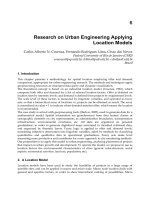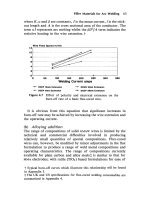Advanced Engineering Dynamics 2010 Part 5 pdf
Bạn đang xem bản rút gọn của tài liệu. Xem và tải ngay bản đầy đủ của tài liệu tại đây (583.39 KB, 20 trang )
74
Rigid body motion in three dimensions
Fig.
4.14
Binet diagram: ellipsoid principal axes
I
,2.3, sphere radius
1.95
Fig.
4.15
Binet diagram: ellipsoid principal axes 1,2,3, sphere radius 2.05
Fig.
4.16
Binet diagram: ellipsoid principal axes 3,2,1, sphere radius 2.6
remains constant.
A
similar situation occurs when tidal effects are present. In both cases it
is
assumed that variations from the nominal shape are small.
The general effect
is
that Binet’s ellipsoid will slowly shrink. For
the
case
of
rotation
about the
3
axis the intersection curve reduces and the motion remains stable, but in the case
Euler
k
angles
75
of rotation close to the
1
axis the intersection curve will slowly increase in size leading to
an unstable condition. Rotation close to the
2
axis is unstable under all conditions.
4.10
Euler's
angles
The previous sections have been concerned, for the most part, with setting up the equa-
tions of motion and looking at the properties of a rigid body. Some insight to the solution
of these equations was gained by means of Poinsot's construction for the case of torque-
free motion.
The equations obtained involved the components of angular velocity and acceleration but
they cannot be integrated to yield angles because the co-ordinate axes are changing in direc-
tion
so
that finite rotation about any of the body axes has no meaning.
We are now going
to'
express the angular velocity in terms of angles which can uniquely
define the orientation of the body. Such a set are Euler's angles which we now define.
Figure
4.17
shows a body rotating about a fixed point
0
(or its centre of mass). The
XYZ
axes are an inertial set with origin
0.
The
xyz
axes are, in the general case, attached to the
body. If the body has an axis of symmetry then this is chosen to be the z axis. Starting with
XYZ
and the
xyz
coincident we impose a rotation of
0
about the
Z
axis.
There then follows
a rotation of
0
about the new
x
axis (the
x'
axis) and finally we give a rotation of
0
about the
final
z
axis.
The angular velocity vector is
0
=
0K
+
ei'
+Gk
(4.72)
where
K
is the unit vector in the
Z
direction,
i'
is the unit vector in the
x'
direction and
k
is
the unit vector in the
z
direction.
From the figure we see that
K
=
cos(8)
k
+
sin(8)j"
j"
=
cos
(~)j
+
sin
(w)
i
i'
=
cos(y)i
-
sin(w)j
(4.73)
(4.74)
(4.75)
Fig.
4.17
76
Rigid body
motion
in
three dimensions
Thus
K
=
cos
(0)
k
+
sin
(e)
cos
(v)j
+
sin
(e)
sin
(w)
i
Writing
(4.76)
o
=
o,i
+
o,j
+
o,k
(4.77)
and substituting for
K
and
i’
in equation
(4.72)
gives
0,
=
ir
sin
e
sin
y
+
6
cosy
+
o
0,
=
0
sine cosw
-
0
shy
+
0
W,
=
rir
COS
e
+O
+w
(4.78)
4.1
1
The symmetrical body
The equation for angular velocity given in the previous section, even when used in con-
junction with principal co-ordinates, leads to lengthy expressions when substituted into
Euler’s equations or Lagrange’s equations. For the body whose axis
of
symmetry is the
z
axis
(so
that
I,
=
IJ
the
xyz
axes need not be rotated about the
z
axis. This means that for
the axes
w
is
zero. Nevertheless the body still has an angular velocity component
\ir
about
the
z
axis.
For the axes
0,
=
a.4
+
a,j
+
ilzk
where
(4.79)
For the body
0,
=
0
0,.
=
bsin
8 (4.80)
a,=
rircose
+
w
These terms may now be inserted into the modified Euler’s equations
(4.42)
to give
M,
=
1,6
-
(I,
-
I,)
2
sinocos
e
+
I,&
sine
M,.
=
I,
(dj
sin
e
+
biIcos
e)
-
(z3
-
I,)
0C)cos
e
-
I@
(4.8
1)
a
at
M;
=
z3-
COS^
+
$1
Alternatively we can write an expression for the kinetic energy
and substituting the angular velocities from equation
(4.80)
gives
1 1
1
2
2 2
T
=
-
I,$
+
-
1,b2
sin2@
+
-
z3
(b
cos
e
+
w)’
(4.82)
The symmetrical body
77
It
is interesting to note that use
of
equation
(4.78)
gives
the same result because
(of
+
of
)
does
not contain
w.
We now consider the classic case
of
the symmetric top in a gravitational field
-gK.
Figure
4.18
shows the relevant data.
The torque is
M,
=
mgh
sin(8)
i
(4.83)
and the potential energy
V
=
mgh
cos 8
(4.84)
We choose to use Lagrange’s equations because they yield some first integrals in a con-
venient form. The Lagrangian
(P
=
T
-
V)
is
1 1 1
2
2
2
P
=
-
I,$
+
-
Z,02sin28
+
-
Z3
(91
cos 8
+
\ir)’
-
mgh
cos
e
(4.85)
from which we see that neither
y~
nor
0
appear explicitly in the Lagrangian (they
are
cyclic
or ignorable). Therefore we have
two
first integrals of the motion in the
form
of constant
generalized momenta
Z3
(\ir
+
91
cos e)
=
constant
(4.86)
ax
pw
=
&=
and
ax
p,,
=
7
=
I,
91
sin’
e
+
z3
<\ir
+
0
cos e) cos
e
a0
=
I,
0
sin’
e
+
pv
cos
e
=
constant
(4.87)
Because time does not appear explicitly in the Lagrangian the energy,
E,
is constant
1
1 1
2 2 2
E
=
-
ZIe2
+
-
Z,b2sin2B
+
-
Z3
(91
cos 8
+
\irf
+
rngh
cos
8
(4.88)
Fig.
4.18
78
Rigid
body
motion in three dimensions
Substituting equations
(4.86)
and
(4.8.7)
into
(4.88)
gives
1
(P,
-
P,cos~)2
P:
E
=
-
Z,e2
+
+
-
+
mgh
cos8
(4.89)
2 21, sin2
0
213
Equation
(4.89)
can be rearranged in the following form
1
2
E’
=
-
z,e2
+
v
(e)
where the constant
P:
213
E’
=
E
-
-
is the effective energyand
(4.90)
(Pa
-
P,cos8)2
v=
+
mgh
cos0
(4.91)
which is a function of
8
only and may be considered to be a ‘pseudo’ potential energy.
A
typical plot of
V‘
and
E’
against
8
is shown in Fig.
4.19.
In this case the shaded area is the
region where
6’
is positive and is therefore the only possible values of
8
for the given initial
conditions. It is seen that
8
oscillates between levels
0,
and
8,
whilst
O3
is the value of
8
where8
=
0.
2Z, sin2
8
We shall next generate Lagrange’s equation for
8
as
the generalized co-ordinate
d
aP
az
dt(
%)
-z=O
The right hand side is zero because it is assumed that there is no friction or other forces
applied; the effect of gravity is covered by the potential energy term.
Thus
Z,G
-
[
Z,S2
sin
e
cos
8
-
Z3
(0
cos
8
+
\it)
(0
sin
8)
+
mgh
sin
0
3
(4.92)
Now from equation
(4.86)
z,
(0
COS
8
+
+)
=
z30,
Spin speed
=5
Critical
spin speed
Fig.
4.19
ne
symmetn'cal
body
79
Therefore
Z,e
=
(-Z3azb
+
Z,S2
cos
8
+
mgh
)
sin
8
=
0
-13azb +
llb2
cos8
+
mgh
=
0
(4.93)
(4.94)
For
6
=
0
and
8
not equal to zero
This expression is valid for
0
=
0
and is independent of
6
so
it
is
true
for
the case of steady
precession where
8
=
0.
It is convenient to rewrite equation
(4.94)
as
Z30,
1
mgh
1
2
COS^
=
-
I,
(&T
(B)
(4.95)
A
plot of cos
8
against
11
S
is shown in Fig.
4.20.
The maximum value for cos
8
is found
by equating the slope of the curve to zero,
dcos
8
Z30,
2mgh
-
-
($)
=
0
(4.96)
d
(l/S)
I,
I,
I10
=
Z3
0;
I
2mgh
so
the maximum occurs when
(4.97)
and
the maximum value
for cos
8
is
Z:0f
COS^,,
=
-
(4.98)
For the special case of
8
=
0
the minimum value of
0,
that will maintain stable motion with
the axis vertical is
4mghZ,
W:,crit
=
\
(4WI
'
1:)
(4.99)
This condition is that of the 'sleeping top'.
The motion of the
z
axis can be found by numerically integrating equation
(4.93)
in con-
junction with equation
(4.87)
to generate
8
and
0
as
functions of time. Some typical results
are shown in Figs
4.2
1
to
4.24.
If the initial precessional speed
is
that corresponding to those
for steady precession then a circular motion is achieved. The time for one revolution about
Fig.
4.20
80
Rigid
body
motion
in
three dimensions
Fig.
4.21
Fig.
4.22
the
2
axis for initial speeds not equal to a steady precessional speed varies slightly for small
oscillations of
8
and when
0
is in the range
0
to a little above the slow precessional speed.
A
plot of the ratio of precessional time to time for steady precession against initial preces-
sional speed is
shown
in Fig.
4.25.
4.12
Forced precession
So
far we have considered the body to be free to respond to applied torques, or the absence
of torque.
A
much simpler problem is to determine the torques required to give a prescribed
motion to a body. We shall tackle a specific problem and find the solution by the direct appli-
cation of
first
principles.
Figure
4.26
depicts a rigid symmetrical wheel W which runs, with negligible friction, on
axle
A.
The axle is freely pivoted to a block which is free to rotate about the vertical
2
axis.
The wheel is rotating relative to the axle at a speed
$
and the whole assembly is rotated
Fig. 4.23
Fig. 4.24
Fig. 4.25
82
Rigid body motion
in
three dimensions
Fig.
4.26
about the
Z
axis at a constant angular speed
of
0.
The moment
of
inertia
of
the wheel about
its axis, the
z
axis, is
Z3
and the moment
of
inertia
of
the wheel and axle about the
y
and
x
axes is
I,.
EXAMPLE
Determine the torque which must be applied to the axle about the
x
axis
so
that
the angle
8
is maintained constant.
The angular velocity about the
z
axis is
w
+
rtr
COS
e
=
aL
(9
and the angular velocity about the yaxis is
$
sin
8.
The moment
of
momentum vector is
Lo
=
Z,rtr
sin
(8)j
+
Z,a$
(ii)
From Figs
4.26
and
4.27
we see that the change in the moment
of
momentum
vector is
Z30z
sin
8
d0
i
-
Z,b
sin
8
cos
8
d0
i
=
dL,
Fig.
4.27
Epilogue
83
Thus
(iii)
a0
M,
=
-
=
(I~o,~
-
1,2
cose) sin
(e)
i
dt
but the torque about
0
is
M,
=
(rnghsine
+Q,)i
(iv)
(VI
which is the required holding torque. Since there is no torque about the zaxis
50~
=
5
(\ir
+
B
cos
0)
=
constant.
Equating torques from equations (iii) and (iv) gives
Q,
=
(I,O,O
-
I$
case
-
rngh)
sin
e
If
Q,
is zero we replicate equation
(4.94).
4.13
Epilogue
The reader may well feel at this point that some new basic principle has been uncovered
owing to the somewhat unexpected behaviour of rotating rigid bodies. We appear to come a
long way from Newton’s laws of motion with notions such
as
the moment of inertia tensor
and the need for three-dimensional rotating axes. The fact that torques do not just produce
angular accelerations in a straightforward analogy with particle dynamics seems to require
reconciliation.
A
simple example will serve to illustrate the origins of gyroscopic behaviour. Figure
4.28
shows
two
identical satellites in circular orbit about a massive central body, the satellites
being diametrically opposed.
At
the same instant the satellites receive impulses,
AJ,
normal
to the p!ane of the orbit but in opposite senses. The effect of these impulses is to give each
satellite a velocity of
AJ/m
in the same direction as the impulse. If the initial tangential
velocity is
I/
then the change in direction of the path d0
=
M/(m
V).
This is the simple par-
ticle dynamic solution. However, we can regard the system as originally rotating about the
Fig.
4.28
84
Rigid body motion
in
three dimensions
z
axis; the pair
of
impulses constitute a couple about the
x
axis yet the plane
of
rotation has
rotated about they axis.
We
could solve the problem by equating the impulsive couple to the change in moment
of
momentum, that is
M,dt
=
dL,
M(2r)i
=
IZwZdO
i
AJ2r
=
(2rn:)(V/r)
d0
Thus
giving
dO
=
M/(mv)
as expected.
Dynamics
of
Vehicles
5.1
Introduction
A
vehicle in this chapter is taken to be one which travels on land, in the air or in space. The pur-
pose of the chapter is to bring out some of the characteristic dynamics in the particular domain.
Satellite motion is typified by the motion of a small body about a large body under the
action of a central force. However, for the two-body problem the restriction of one body
being significantly smaller than the other is not restrictive because when considering the
relative
motion
of
two bodies the equations for reIative motion are the same
as
those per-
taining to one small body in orbit about a large one.
5.2
Gravitational potential
Before considering the motion
of
bodies under gravity it is necessary to look at the distinc-
tion between centre
of
mass and centre
of
gravity. If the gravitational field is uniform then
the
two
centres will coincide. One important result which,
so
far, we have taken for granted
is that for a uniform, spherical body the centre of gravity is at the geometric centre;
as
is the
centre of mass.
The quickest method of proving the last statement is to utilize the concept of gravitational
potential. The change in potential is defined to be the negative of the work done by the force
of gravity acting on a unit mass at some point
P.
Figure
5.1
shows a mass
m
and a unit mass
at point
P.
Therefore the change in potential is
dV
=
-Fdr
=
-
-
-
dr
i
3
Thus
Grn
-
+
constant
r
Because ultimately only the differences in potential are required the additive constant can
take any convenient value. In this case we shall make the constant equal to zero.
Note that here
V
is the potential energy for a unit
mass
at the point
P
(or,
the work done
divided by the
mass
at
P)
and is therefore described
as
the
gravitational potential
at the
point
P.
In many texts
-
7
is
called the gravitational potential.
86
Dynamics
of
vehicles
Fig.
5.1
If there are
many
masses then, since the potential is a scalar hnction of position, the total
potential is
v
=
-E%
(5.3)
From the definition of the potential the force in the
r
direction is
dV
a7
E=-
and using the chain rule for differentiation
F=-E
dX
aV
dr
(ax
a7+TT-+S%)
The unit vector in the
r
direction,
e,,
can be expressed in terms of the Cartesian unit vectors
as
e,=$i+=j+
dY
&k
a7
so
t:
)
r
aV. aV
(
ax ay
4
=
I
+
-j
+
-k-e
or
8
=
-F.e,
We define the gravitational field strength,
g,
as the force acting on a unit mass. Therefore
g
=
F
and thus
g
=
i
+
Ej
+
-k
(”,”
ay
aV
az
1
or, using the definition of the gradient of a scalar,
-
g
=
-
VV
=
-gradV
(5.4)
We shall now use the potential
to
find the field due to a thin hollow shell as shown in Fig.
5.2.
The density
of
the material is
p,
the shell thickness is
t
and its radius
is
R.
The point
P
is
situated a distance
x
from the centre of the shell and all points on the elemental annular
ring are a distance
r
from
P.
Gravitational potential
87
Fig.
5.2
The mass
of
the annular ring is
dm
=
p2xRsin0 R d0
t
so
the potential at
P
due to the ring is
Gp2xR2t sin0 d0
dV
=
-
r
Now the mass
of
the whole shell is
m
=
p4aR2t
Therefore
(5.5)
Gm sin0 d0
dV
=
-
2r
Using the cosine rule
-
2Rx
cos0
(5.6)
y
=
x2
+
R~
and differentiating gives
(5.7)
2
2r dr
=
2Rx
sin0 d0
Substituting equation
(5.7)
into equation
(5.5)
gives
Gm dr
2xR
dV
=
Integration produces
v
=
-1
-dr Gm
=
[r2
Gm
-r,]
2xR 2xR
(5.7a)
ri
For the case as
shown
r2
=
x
+
R and
r,
=
x
-
R.
Thus
(5.8)
Gm
v
=
X
which
is
identical to the result
for
a point
mass
of
m
at the centre. Applying equation
(5.4)
to
equation
(5.8)
88
Dynamics
of
vehicles
Fig.
5.3
Gm
g=-
7-i
(5.9)
X
If the point
P
is inside the shell we must re-examine the limits. By the definition of poten-
tial
r
must be positive
so,
from Fig.
5.3,
we have that
r2
=
R
+
x
and
r,
=
R
-x
which, when substituted into equation (5.7a), gives
(5.10)
which is constant for any point inside the shell. From equation
(5.4)
it follows that the field
is zero.
For a body comprising concentric spherical shells the field outside the body will be as if
all the mass is concentrated at the centre. The field inside the body will be due only to the
mass which is at a radius smaller than the distance of
P
from the centre, the outer shells mak-
ing no contribution.
If
a body,
of
radius
R,
has a uniform density then the field at radius
a
(a
<
R)
will be
Gm
v
=
R
(5.1 1)
From the above arguments it can be seen that
two
spherically symmetric bodies will attract
4
31
4
g
=
Gp-rca
-
=
Gp-rca
3
a2
3
each other as if each was a point mass concentrated at their respective centres.
5.3
The
two-body
problem
Figure
5.4
shows
two
spherical bodies under the action of equal but opposite central
forces
F,,
and
6,.
The centre
of
mass lies along the line joining the centres at a position
such that
m,r,
=
m2r2
With the separation
of
the bodies being
s
then we can define a mass
p
so
that
m,r,
=
m,r,
=
ps
(5.12)
The two-body problem
89
Fig.
5.4
Now
s=rl+y2=E+cIs= m, m2
-(&+A)
Therefore
(5.13)
By conservation of momentum the centre of
mass
will be unaccelerated and this will
initially be chosen as the origin. By conservation of moment of momentum we can fix a
direction for one of the inertial axes. The moment
of
momentum vector can be written as
two
components, one along the line joining the centres and one normal to it. The component
along the line will be due to the spin of the bodies and this will have no effect on the moment
of momentum normal to the line. It follows that the motion of the two bodies will be con-
fined to the plane which contains the line of centres and has
L,
as its normal.
We can now write the equations of motion for the
two
masses in polar co-ordinates.
Resolving radially we have
(5.14)
1
1
-+-
1-
_-
P
m, m2
2
2
IF,^^
=
m,w
r,
-
mI?,
=
m2m
r,
-
m2r2
and taking moments about the centre of
mass
(C
of
M)
gives
0
=
m,(r,&
+
2wi,)
=
m2(r2&
+
2wi2)
or
(5.15)
o
=
1
~(m,r~w)
=
z
1
g(m2r:w)
rl
Substituting equation
(5.12)
into equation
(5.14)
gives
lF121
=
p2s
+
CLj:
(5.16)
Now
2
2
L,
=
mlrl
o
+
m2r2m
90
Dynamics
of
vehicles
and again using equation
5.12
L,
=
pr,o
+
pr20
=
po(r,
+
r2)
(5.17)
So
we see that the motion is identical to that of a body of mass
J.I
at a distance
s
from a
fixed body. The quantity
J.I
is
known
as the
reduced mass.
We shall now consider the central
force problem because any
two-mass
system can be replaced by a single
mass
under the
action of a central force.
5.4
The central force
problem
Figure
5.5
shows a body
of
mass
m
at a distance
r
from the origin of a central force
F(r)
act-
ing towards the origin.
As
already discussed the motion is in a plane
so
we can write the
equations of motion directly in polar co-ordinates.
2
=
psw
In the radial direction
.2
-F(r)
=
mi:
-
mr0
(5.18)
and normal to the radius
O
=
mr0
i
m2r8
=
L
rZ
d
(mr2,j)
(5.19)
Now
mr26
=
L
is the moment of momentum and therefore constant. Eliminating
6
in equa-
tion
(5.18)
leads to
L2
-F(r)
=
mi:
-7
Dividing through by
m
we have
mr
-f(r)
=
i:
-3
L9
(5.20)
where
L*
is the moment of momentum per unit mass.f(r) is the central force per unit mass;
let this force be
Kr".
Noting that
i:
=
rdr/dr, integrating equation
(5.20)
with respect to
r
provides
r
Kr"+'
- -
-
r2
+ E
L9
(5.21)
(n+l)
2
2:
or,
ifn
=
-
1,
Fig.
5.5
The
central force
problem
9
1
(5.21a)
*2
L'
2 2:
-Klog(r)
=
L
+
-
-
E'
where the constant
E*
has the dimensions of energy per unit mass.
Equations (5.21) and (5.21a) may be written
L2
1
Kr""
2 ((n+l) 2:
L*2
1
.2
-
r= +-
+E*
or, withn
=
-
1,
K
log(r)
+
2
+
E*
2r
(5.22)
The tenns in the large parentheses can be regarded
as
a pseudo potential
'V'.
A
plot of
'V'
versus radius for various integer values of
n
is given in Fig. 5.6. It is seen that for certain
values of n the curve exhibits a minimum and for others a maximum. Simple differentiation
of
'V'
with respect to
r
reveals that for
n
>
-3
the curve has a minimum and for
n
<
-3
the
curve has a maximum. The curves are drawn for a fixed value of moment
of
momentum and
all (bar
n
=
-3)
show that for some range of values of
E*
there are two value of
r
for
r'
=
0.
In the cases where
'
V'
exhibits a minimum the value of
r'*
>
0
giving a real value for
r'
and thus stable motion occurs between the inner and outer bounds. The motion is said to be
bounded.
We now wish to know which values of
n
lead to closed orbits, that is orbits which repeat
themselves after an integer number of orbits.
A
useful change of variable is
r
=
1
/u.
Differentiation with respect to
t
gives
-2
-=
r
-(
2
=
-'vy
+
E'
dr
-
1
du
6
dt
u2
de
L'
=
r2i,
=
elu
-
_-
Now
.2
Fig.
5.6
Constant chosen to give non-intersecting curves.
92
Dynamics
of
vehicles
and therefore
dr du
-
= L
dt de
and
Substitution of equation
(5.23)
into equation
(5.20)
gives
or
(5.23)
(5.24)
If
u
is constant, that is a circular orbit
of
inverse radius
uo,
then
Let us now assume that
u
=
uo
+
&(e)
where
E
is small.
Substitution into equation
(5.24)
leads to
d2E
K
-(n+2)
-
+
&
=
-(uo
+
E)
-240
de2 L'2
Expanding the right hand side by the binomial theorem and neglecting terms above the first
order gives
=
-(n
+
2)~
so
d2E
de2
-
+
(3
+
n)E
=
0
(5.25)
This is the equation of simple harmonic motion
(SHM)
with the solution
E
=
Eo
cos(p0
+
0)
(5.26)
where
p
=
d(3
+
n),
0
is
a
constant
of
integration and
q,
is
a
small
amplitude. From this
it
is
clear that
n
must be greater than
-3
for sinusoidal error motion, which agrees with the
result obtained from the pseudo potential. We may further argue that if the orbit is closed
after one cycle then
p
must be an integer
so
that
or
2
n=p
-3
Some
of
the values are
Satellite motion
93
p=l
n=-2
p=2
n=
1
p=3
n=
6
p=4
n=
13
Notice that the only negative value of
n
is
-2,
which is the inverse square law. The second
value with
n
=
1
is Hooke’s law.
If we let
p
be the ratio of
two
integers then a krther series of non-integer values of
n
are
generated which indicate paths which close after a finite number of orbits. However, more
detailed analysis carried out by Bertrand in 1873 leads to the conclusion that for large devi-
ations from the circular orbit only the inverse square law and Hooke’s law generate closed
orbits. Numerical integration of equation
(5.24)
supports this theory. See Figs 5.7(a) and
5.7(b).
Fig.
5.7
(a)
Apsides
stationary.
(b)
Apsides precess slowly.
Astronomical observations have to date revealed only closed orbits other than deviations
due to extra bodies or the effects of Einstein’s theory of relativity. This lends weight to the
belief that the inverse square law
of
gravitational attraction is universal.
5.5
Satellite
motion
We shall now consider the case for
n
=
-2,
that is the inverse square law of attraction.
Equation
(5.24)
becomes









